CECOS College DET Unit 502: Learning Theories and Application
VerifiedAdded on 2023/01/05
|22
|7490
|1
Report
AI Summary
This report, prepared for DET Unit 502 at CECOS College London, delves into the core concepts of learning theories, principles, and models. It examines cognitive, behavioral, and constructivist learning theories, exploring their practical applications in teaching, learning, and assessment. The report further investigates communication theories, assessment methods, and curriculum development, highlighting how these elements contribute to effective educational practices. It also covers models of learning preferences, emphasizing the importance of individual learner needs, inclusive teaching, and reflective practices. The report concludes with an analysis of reflection and evaluation, providing insights into continuous improvement in education and training. The student provides a critical review of literature, incorporating their teaching practice and experience to offer a comprehensive understanding of the subject matter.
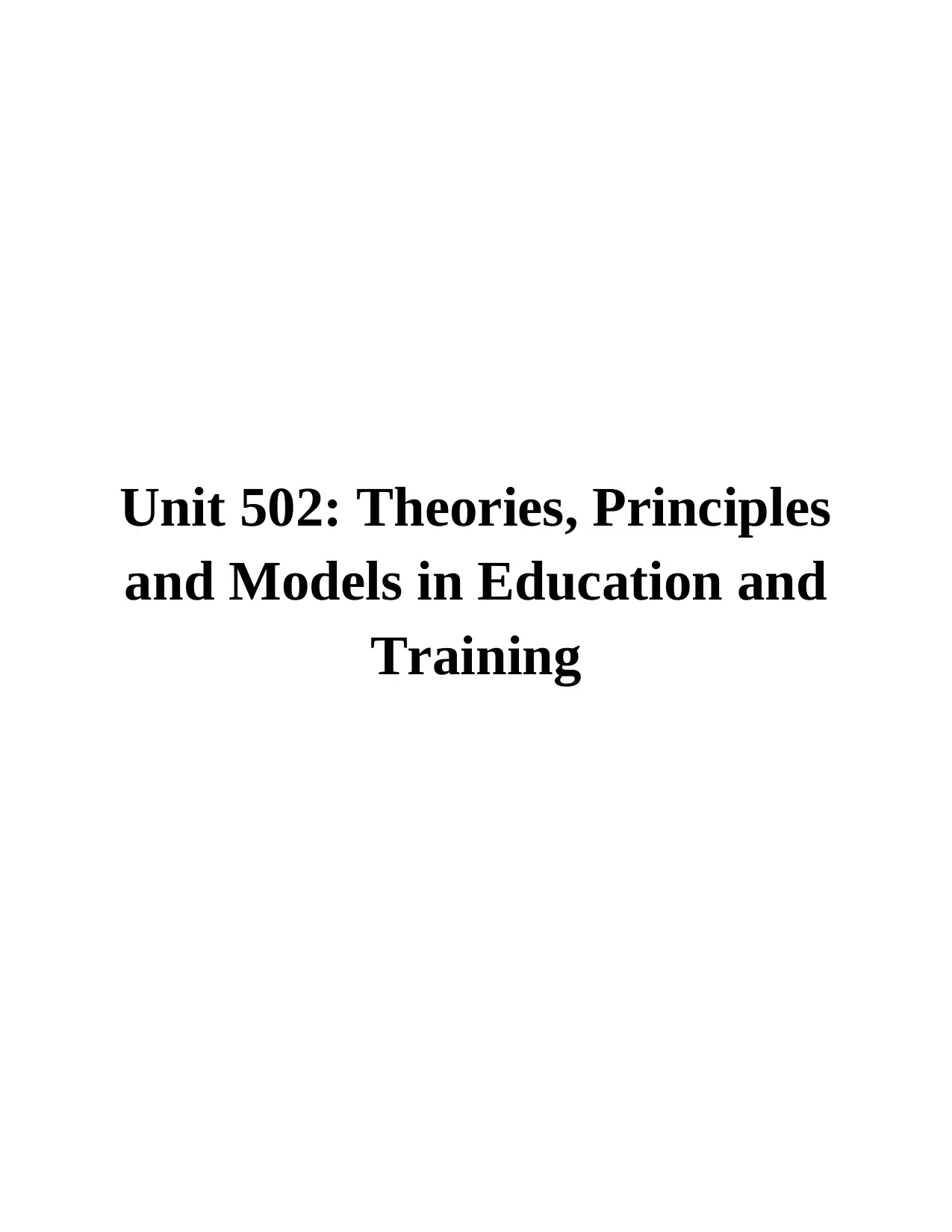
Unit 502: Theories, Principles
and Models in Education and
Training
and Models in Education and
Training
Paraphrase This Document
Need a fresh take? Get an instant paraphrase of this document with our AI Paraphraser
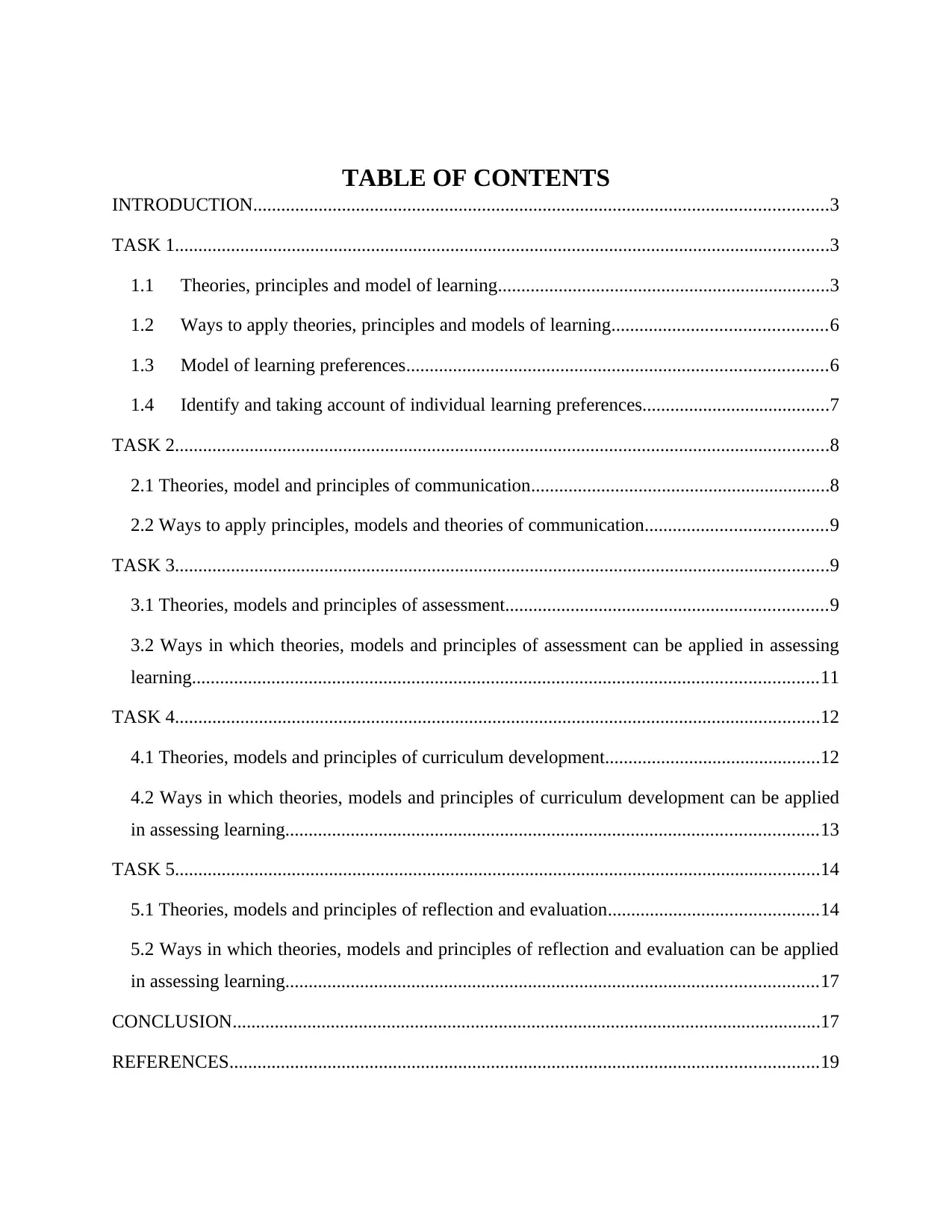
TABLE OF CONTENTS
INTRODUCTION...........................................................................................................................3
TASK 1............................................................................................................................................3
1.1 Theories, principles and model of learning.......................................................................3
1.2 Ways to apply theories, principles and models of learning..............................................6
1.3 Model of learning preferences..........................................................................................6
1.4 Identify and taking account of individual learning preferences........................................7
TASK 2............................................................................................................................................8
2.1 Theories, model and principles of communication................................................................8
2.2 Ways to apply principles, models and theories of communication.......................................9
TASK 3............................................................................................................................................9
3.1 Theories, models and principles of assessment.....................................................................9
3.2 Ways in which theories, models and principles of assessment can be applied in assessing
learning......................................................................................................................................11
TASK 4..........................................................................................................................................12
4.1 Theories, models and principles of curriculum development..............................................12
4.2 Ways in which theories, models and principles of curriculum development can be applied
in assessing learning..................................................................................................................13
TASK 5..........................................................................................................................................14
5.1 Theories, models and principles of reflection and evaluation.............................................14
5.2 Ways in which theories, models and principles of reflection and evaluation can be applied
in assessing learning..................................................................................................................17
CONCLUSION..............................................................................................................................17
REFERENCES..............................................................................................................................19
INTRODUCTION...........................................................................................................................3
TASK 1............................................................................................................................................3
1.1 Theories, principles and model of learning.......................................................................3
1.2 Ways to apply theories, principles and models of learning..............................................6
1.3 Model of learning preferences..........................................................................................6
1.4 Identify and taking account of individual learning preferences........................................7
TASK 2............................................................................................................................................8
2.1 Theories, model and principles of communication................................................................8
2.2 Ways to apply principles, models and theories of communication.......................................9
TASK 3............................................................................................................................................9
3.1 Theories, models and principles of assessment.....................................................................9
3.2 Ways in which theories, models and principles of assessment can be applied in assessing
learning......................................................................................................................................11
TASK 4..........................................................................................................................................12
4.1 Theories, models and principles of curriculum development..............................................12
4.2 Ways in which theories, models and principles of curriculum development can be applied
in assessing learning..................................................................................................................13
TASK 5..........................................................................................................................................14
5.1 Theories, models and principles of reflection and evaluation.............................................14
5.2 Ways in which theories, models and principles of reflection and evaluation can be applied
in assessing learning..................................................................................................................17
CONCLUSION..............................................................................................................................17
REFERENCES..............................................................................................................................19
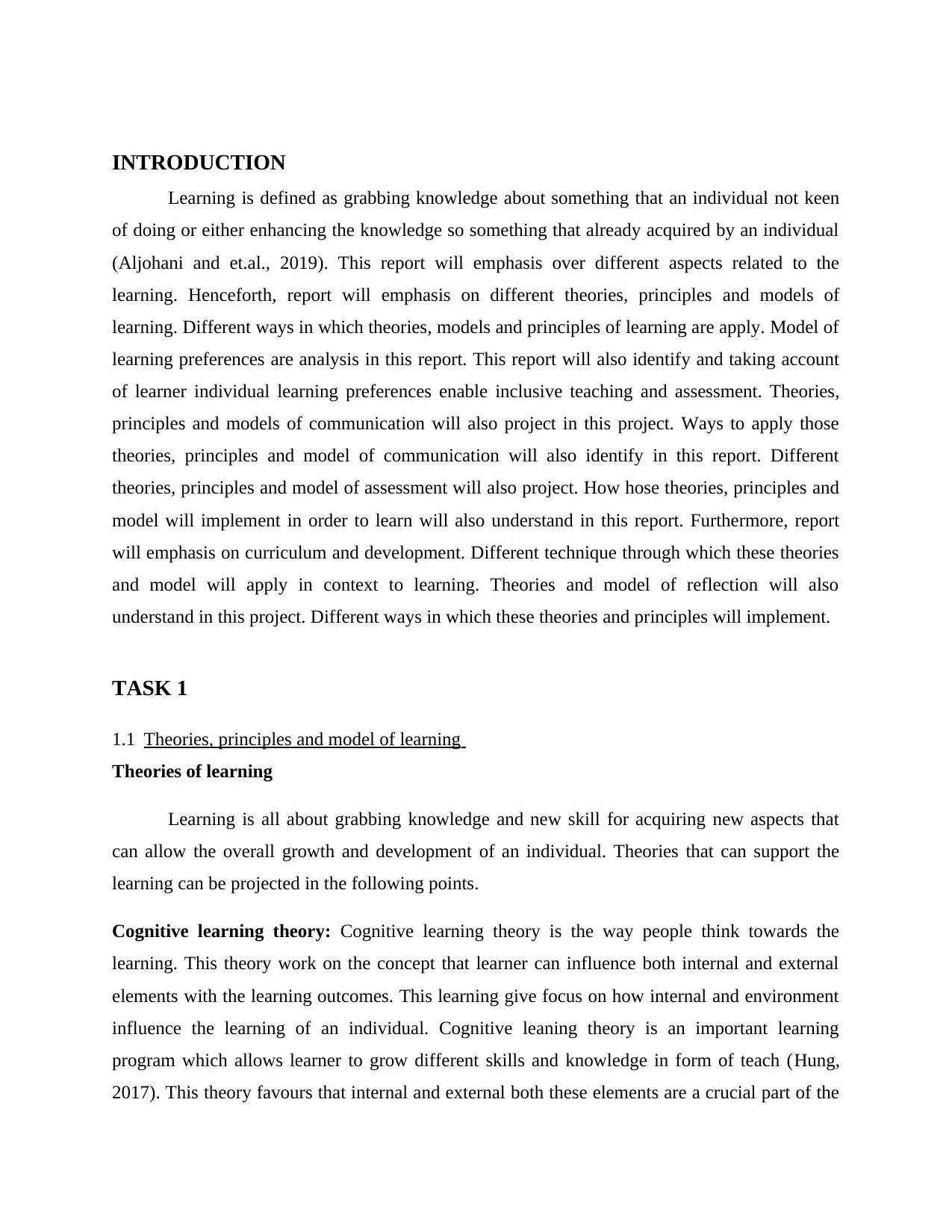
INTRODUCTION
Learning is defined as grabbing knowledge about something that an individual not keen
of doing or either enhancing the knowledge so something that already acquired by an individual
(Aljohani and et.al., 2019). This report will emphasis over different aspects related to the
learning. Henceforth, report will emphasis on different theories, principles and models of
learning. Different ways in which theories, models and principles of learning are apply. Model of
learning preferences are analysis in this report. This report will also identify and taking account
of learner individual learning preferences enable inclusive teaching and assessment. Theories,
principles and models of communication will also project in this project. Ways to apply those
theories, principles and model of communication will also identify in this report. Different
theories, principles and model of assessment will also project. How hose theories, principles and
model will implement in order to learn will also understand in this report. Furthermore, report
will emphasis on curriculum and development. Different technique through which these theories
and model will apply in context to learning. Theories and model of reflection will also
understand in this project. Different ways in which these theories and principles will implement.
TASK 1
1.1 Theories, principles and model of learning
Theories of learning
Learning is all about grabbing knowledge and new skill for acquiring new aspects that
can allow the overall growth and development of an individual. Theories that can support the
learning can be projected in the following points.
Cognitive learning theory: Cognitive learning theory is the way people think towards the
learning. This theory work on the concept that learner can influence both internal and external
elements with the learning outcomes. This learning give focus on how internal and environment
influence the learning of an individual. Cognitive leaning theory is an important learning
program which allows learner to grow different skills and knowledge in form of teach (Hung,
2017). This theory favours that internal and external both these elements are a crucial part of the
Learning is defined as grabbing knowledge about something that an individual not keen
of doing or either enhancing the knowledge so something that already acquired by an individual
(Aljohani and et.al., 2019). This report will emphasis over different aspects related to the
learning. Henceforth, report will emphasis on different theories, principles and models of
learning. Different ways in which theories, models and principles of learning are apply. Model of
learning preferences are analysis in this report. This report will also identify and taking account
of learner individual learning preferences enable inclusive teaching and assessment. Theories,
principles and models of communication will also project in this project. Ways to apply those
theories, principles and model of communication will also identify in this report. Different
theories, principles and model of assessment will also project. How hose theories, principles and
model will implement in order to learn will also understand in this report. Furthermore, report
will emphasis on curriculum and development. Different technique through which these theories
and model will apply in context to learning. Theories and model of reflection will also
understand in this project. Different ways in which these theories and principles will implement.
TASK 1
1.1 Theories, principles and model of learning
Theories of learning
Learning is all about grabbing knowledge and new skill for acquiring new aspects that
can allow the overall growth and development of an individual. Theories that can support the
learning can be projected in the following points.
Cognitive learning theory: Cognitive learning theory is the way people think towards the
learning. This theory work on the concept that learner can influence both internal and external
elements with the learning outcomes. This learning give focus on how internal and environment
influence the learning of an individual. Cognitive leaning theory is an important learning
program which allows learner to grow different skills and knowledge in form of teach (Hung,
2017). This theory favours that internal and external both these elements are a crucial part of the
⊘ This is a preview!⊘
Do you want full access?
Subscribe today to unlock all pages.

Trusted by 1+ million students worldwide
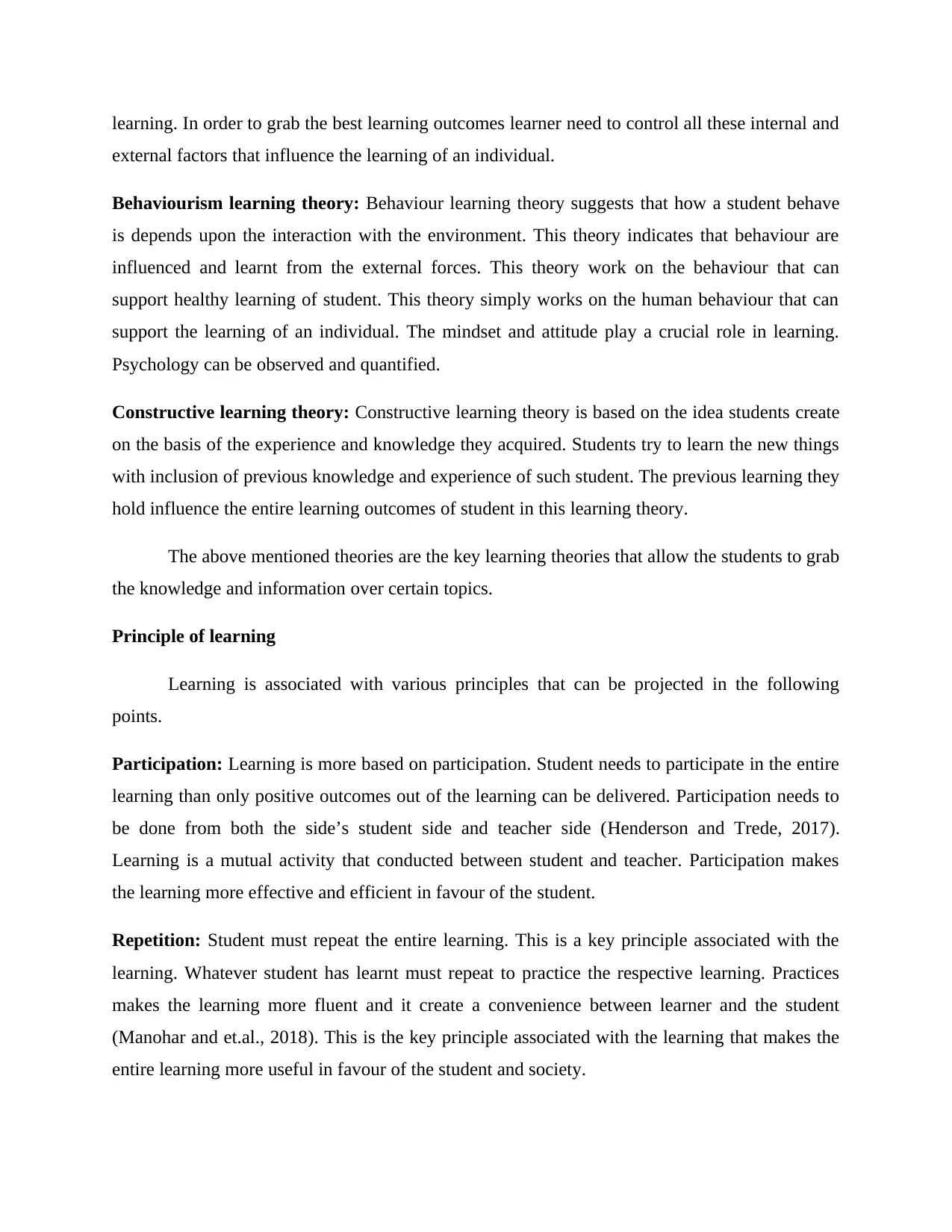
learning. In order to grab the best learning outcomes learner need to control all these internal and
external factors that influence the learning of an individual.
Behaviourism learning theory: Behaviour learning theory suggests that how a student behave
is depends upon the interaction with the environment. This theory indicates that behaviour are
influenced and learnt from the external forces. This theory work on the behaviour that can
support healthy learning of student. This theory simply works on the human behaviour that can
support the learning of an individual. The mindset and attitude play a crucial role in learning.
Psychology can be observed and quantified.
Constructive learning theory: Constructive learning theory is based on the idea students create
on the basis of the experience and knowledge they acquired. Students try to learn the new things
with inclusion of previous knowledge and experience of such student. The previous learning they
hold influence the entire learning outcomes of student in this learning theory.
The above mentioned theories are the key learning theories that allow the students to grab
the knowledge and information over certain topics.
Principle of learning
Learning is associated with various principles that can be projected in the following
points.
Participation: Learning is more based on participation. Student needs to participate in the entire
learning than only positive outcomes out of the learning can be delivered. Participation needs to
be done from both the side’s student side and teacher side (Henderson and Trede, 2017).
Learning is a mutual activity that conducted between student and teacher. Participation makes
the learning more effective and efficient in favour of the student.
Repetition: Student must repeat the entire learning. This is a key principle associated with the
learning. Whatever student has learnt must repeat to practice the respective learning. Practices
makes the learning more fluent and it create a convenience between learner and the student
(Manohar and et.al., 2018). This is the key principle associated with the learning that makes the
entire learning more useful in favour of the student and society.
external factors that influence the learning of an individual.
Behaviourism learning theory: Behaviour learning theory suggests that how a student behave
is depends upon the interaction with the environment. This theory indicates that behaviour are
influenced and learnt from the external forces. This theory work on the behaviour that can
support healthy learning of student. This theory simply works on the human behaviour that can
support the learning of an individual. The mindset and attitude play a crucial role in learning.
Psychology can be observed and quantified.
Constructive learning theory: Constructive learning theory is based on the idea students create
on the basis of the experience and knowledge they acquired. Students try to learn the new things
with inclusion of previous knowledge and experience of such student. The previous learning they
hold influence the entire learning outcomes of student in this learning theory.
The above mentioned theories are the key learning theories that allow the students to grab
the knowledge and information over certain topics.
Principle of learning
Learning is associated with various principles that can be projected in the following
points.
Participation: Learning is more based on participation. Student needs to participate in the entire
learning than only positive outcomes out of the learning can be delivered. Participation needs to
be done from both the side’s student side and teacher side (Henderson and Trede, 2017).
Learning is a mutual activity that conducted between student and teacher. Participation makes
the learning more effective and efficient in favour of the student.
Repetition: Student must repeat the entire learning. This is a key principle associated with the
learning. Whatever student has learnt must repeat to practice the respective learning. Practices
makes the learning more fluent and it create a convenience between learner and the student
(Manohar and et.al., 2018). This is the key principle associated with the learning that makes the
entire learning more useful in favour of the student and society.
Paraphrase This Document
Need a fresh take? Get an instant paraphrase of this document with our AI Paraphraser

Relevance: Relevance should also be a part of learning. This is the key principle associated with
the learning. Student must relive over the process of learning. This makes the learning more
effective and useful.
Transference: Learning involves transference of knowledge. Teacher guide the student the
knowledge and whatever the teacher knew transfer it into the student. Transfer of knowledge and
information is a significant part of learning.
Feedback: Regular feedbacks also involved in learning. The knowledge student grabs needs to
be tasted by the teacher. In order to take feedback teacher ask question and take taste to check
whether the student could grab the knowledge in the way teacher has delivered to the student or
not.
The above mentioned principles are the key principles associated with the learning.
Models of learning
Following are the models associated with the learning.
Contextual learning model: Contextual learning model inter connect the learning modules with
the real world examples. This model inters link learning with practical situations and derives the
best learning results in favour of the student. This model makes the learning more
understandable and indicates the practical implications of learning in specific situations.
Cooperative learning model: This meaning work on the fundamental where group of students
come together and initiate learning. This is an effective technique that consumes more than one
student to conduct the learning outcomes (Wanner and Palmer, 2018). All such students also
become part of the learning and can support other students in solving their personal doubts.
Quantum learning model: Quantum learning model consumes already existed learning
technique to implement the learning. This is a key technique which involves both old as well
new techniques to learn.
Integrated learning model: In this concept students at both the level individual level and in
group try to grab knowledge of learning. This is a critical approach to grab the knowledge. This
the learning. Student must relive over the process of learning. This makes the learning more
effective and useful.
Transference: Learning involves transference of knowledge. Teacher guide the student the
knowledge and whatever the teacher knew transfer it into the student. Transfer of knowledge and
information is a significant part of learning.
Feedback: Regular feedbacks also involved in learning. The knowledge student grabs needs to
be tasted by the teacher. In order to take feedback teacher ask question and take taste to check
whether the student could grab the knowledge in the way teacher has delivered to the student or
not.
The above mentioned principles are the key principles associated with the learning.
Models of learning
Following are the models associated with the learning.
Contextual learning model: Contextual learning model inter connect the learning modules with
the real world examples. This model inters link learning with practical situations and derives the
best learning results in favour of the student. This model makes the learning more
understandable and indicates the practical implications of learning in specific situations.
Cooperative learning model: This meaning work on the fundamental where group of students
come together and initiate learning. This is an effective technique that consumes more than one
student to conduct the learning outcomes (Wanner and Palmer, 2018). All such students also
become part of the learning and can support other students in solving their personal doubts.
Quantum learning model: Quantum learning model consumes already existed learning
technique to implement the learning. This is a key technique which involves both old as well
new techniques to learn.
Integrated learning model: In this concept students at both the level individual level and in
group try to grab knowledge of learning. This is a critical approach to grab the knowledge. This

model is a combination of more than one technique of learning in which student get to grab
knowledge at both the level individual and group level.
Model problem based learning: This learning is not based on what student can grab but this is
rather based on what can be conveyed to student once the learning process start. The process of
learning involve multiple issues with student they face in order to grab the knowledge (Mulyana,
Rusdi and Vivanti, 2018). All such issues and problems student’s face they discuss with other
students and teacher and by solving the doubt learning is completed in this method.
The above mentioned models are the key techniques to conduct the learning program.
1.2 Ways to apply theories, principles and models of learning
These are the specific ways to apply these learning that can be projected in the following
points.
Conduct training: Conducting training is the best way to implement the learning activity.
Training of students can be done so that knowledge can impart to student (Ismail, Sinayskiy and
Petruccione, 2019). This is the best technique that can be implemented to support the knowledge
in student.
Learning sessions: Learning sessions can be taken of students. Learning session will involve
different learning program. This is the best technique to channelize the learning. This is the best
technique to conduct the learning activity in student.
Feedbacks over learning: Feedbacks are conducted to analysis the efficiency of learning.
Feedback is the way that allows to ask the question from the students about the learning activity
and the effectiveness of the learning sessions.
Test: This is also an approach that can be conducted to identify weather the learning is effective
(Pasquaré Mariotto and Tibaldi, 2020). Test allows the teacher to identify how much the
knowledge students are grabbing out of the learning program.
The above mentioned techniques can be channelized to achieve the overall objectives
behind the learning program.
knowledge at both the level individual and group level.
Model problem based learning: This learning is not based on what student can grab but this is
rather based on what can be conveyed to student once the learning process start. The process of
learning involve multiple issues with student they face in order to grab the knowledge (Mulyana,
Rusdi and Vivanti, 2018). All such issues and problems student’s face they discuss with other
students and teacher and by solving the doubt learning is completed in this method.
The above mentioned models are the key techniques to conduct the learning program.
1.2 Ways to apply theories, principles and models of learning
These are the specific ways to apply these learning that can be projected in the following
points.
Conduct training: Conducting training is the best way to implement the learning activity.
Training of students can be done so that knowledge can impart to student (Ismail, Sinayskiy and
Petruccione, 2019). This is the best technique that can be implemented to support the knowledge
in student.
Learning sessions: Learning sessions can be taken of students. Learning session will involve
different learning program. This is the best technique to channelize the learning. This is the best
technique to conduct the learning activity in student.
Feedbacks over learning: Feedbacks are conducted to analysis the efficiency of learning.
Feedback is the way that allows to ask the question from the students about the learning activity
and the effectiveness of the learning sessions.
Test: This is also an approach that can be conducted to identify weather the learning is effective
(Pasquaré Mariotto and Tibaldi, 2020). Test allows the teacher to identify how much the
knowledge students are grabbing out of the learning program.
The above mentioned techniques can be channelized to achieve the overall objectives
behind the learning program.
⊘ This is a preview!⊘
Do you want full access?
Subscribe today to unlock all pages.

Trusted by 1+ million students worldwide
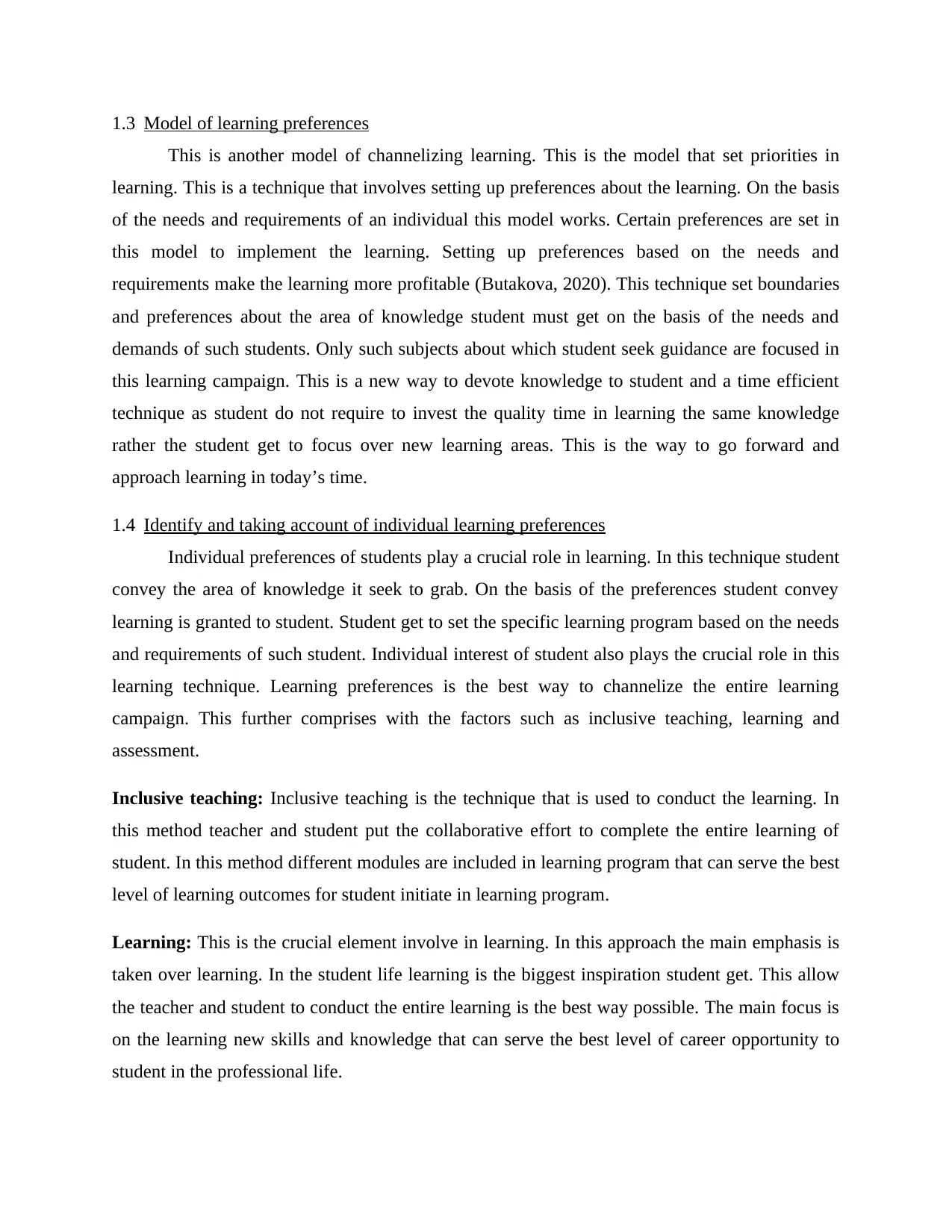
1.3 Model of learning preferences
This is another model of channelizing learning. This is the model that set priorities in
learning. This is a technique that involves setting up preferences about the learning. On the basis
of the needs and requirements of an individual this model works. Certain preferences are set in
this model to implement the learning. Setting up preferences based on the needs and
requirements make the learning more profitable (Butakova, 2020). This technique set boundaries
and preferences about the area of knowledge student must get on the basis of the needs and
demands of such students. Only such subjects about which student seek guidance are focused in
this learning campaign. This is a new way to devote knowledge to student and a time efficient
technique as student do not require to invest the quality time in learning the same knowledge
rather the student get to focus over new learning areas. This is the way to go forward and
approach learning in today’s time.
1.4 Identify and taking account of individual learning preferences
Individual preferences of students play a crucial role in learning. In this technique student
convey the area of knowledge it seek to grab. On the basis of the preferences student convey
learning is granted to student. Student get to set the specific learning program based on the needs
and requirements of such student. Individual interest of student also plays the crucial role in this
learning technique. Learning preferences is the best way to channelize the entire learning
campaign. This further comprises with the factors such as inclusive teaching, learning and
assessment.
Inclusive teaching: Inclusive teaching is the technique that is used to conduct the learning. In
this method teacher and student put the collaborative effort to complete the entire learning of
student. In this method different modules are included in learning program that can serve the best
level of learning outcomes for student initiate in learning program.
Learning: This is the crucial element involve in learning. In this approach the main emphasis is
taken over learning. In the student life learning is the biggest inspiration student get. This allow
the teacher and student to conduct the entire learning is the best way possible. The main focus is
on the learning new skills and knowledge that can serve the best level of career opportunity to
student in the professional life.
This is another model of channelizing learning. This is the model that set priorities in
learning. This is a technique that involves setting up preferences about the learning. On the basis
of the needs and requirements of an individual this model works. Certain preferences are set in
this model to implement the learning. Setting up preferences based on the needs and
requirements make the learning more profitable (Butakova, 2020). This technique set boundaries
and preferences about the area of knowledge student must get on the basis of the needs and
demands of such students. Only such subjects about which student seek guidance are focused in
this learning campaign. This is a new way to devote knowledge to student and a time efficient
technique as student do not require to invest the quality time in learning the same knowledge
rather the student get to focus over new learning areas. This is the way to go forward and
approach learning in today’s time.
1.4 Identify and taking account of individual learning preferences
Individual preferences of students play a crucial role in learning. In this technique student
convey the area of knowledge it seek to grab. On the basis of the preferences student convey
learning is granted to student. Student get to set the specific learning program based on the needs
and requirements of such student. Individual interest of student also plays the crucial role in this
learning technique. Learning preferences is the best way to channelize the entire learning
campaign. This further comprises with the factors such as inclusive teaching, learning and
assessment.
Inclusive teaching: Inclusive teaching is the technique that is used to conduct the learning. In
this method teacher and student put the collaborative effort to complete the entire learning of
student. In this method different modules are included in learning program that can serve the best
level of learning outcomes for student initiate in learning program.
Learning: This is the crucial element involve in learning. In this approach the main emphasis is
taken over learning. In the student life learning is the biggest inspiration student get. This allow
the teacher and student to conduct the entire learning is the best way possible. The main focus is
on the learning new skills and knowledge that can serve the best level of career opportunity to
student in the professional life.
Paraphrase This Document
Need a fresh take? Get an instant paraphrase of this document with our AI Paraphraser
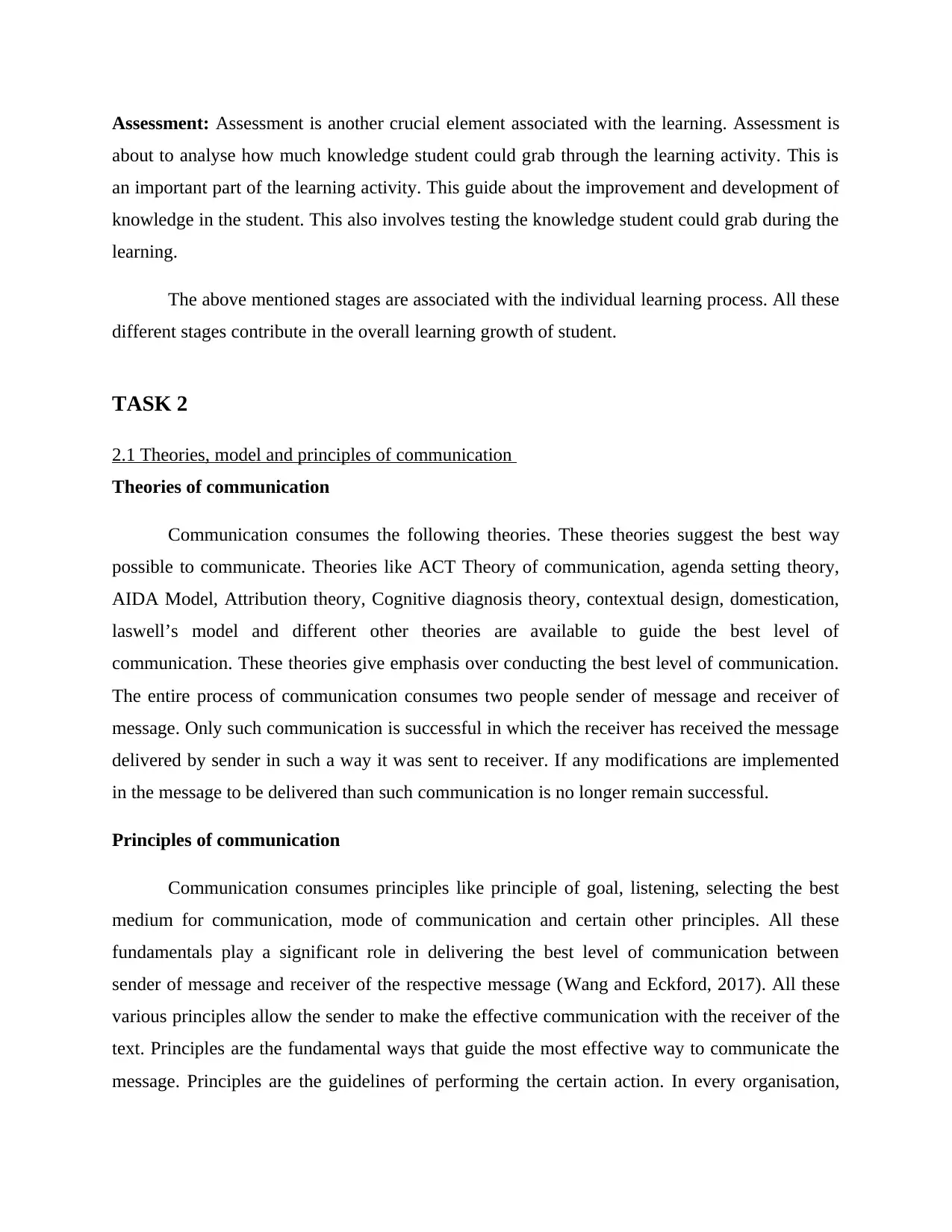
Assessment: Assessment is another crucial element associated with the learning. Assessment is
about to analyse how much knowledge student could grab through the learning activity. This is
an important part of the learning activity. This guide about the improvement and development of
knowledge in the student. This also involves testing the knowledge student could grab during the
learning.
The above mentioned stages are associated with the individual learning process. All these
different stages contribute in the overall learning growth of student.
TASK 2
2.1 Theories, model and principles of communication
Theories of communication
Communication consumes the following theories. These theories suggest the best way
possible to communicate. Theories like ACT Theory of communication, agenda setting theory,
AIDA Model, Attribution theory, Cognitive diagnosis theory, contextual design, domestication,
laswell’s model and different other theories are available to guide the best level of
communication. These theories give emphasis over conducting the best level of communication.
The entire process of communication consumes two people sender of message and receiver of
message. Only such communication is successful in which the receiver has received the message
delivered by sender in such a way it was sent to receiver. If any modifications are implemented
in the message to be delivered than such communication is no longer remain successful.
Principles of communication
Communication consumes principles like principle of goal, listening, selecting the best
medium for communication, mode of communication and certain other principles. All these
fundamentals play a significant role in delivering the best level of communication between
sender of message and receiver of the respective message (Wang and Eckford, 2017). All these
various principles allow the sender to make the effective communication with the receiver of the
text. Principles are the fundamental ways that guide the most effective way to communicate the
message. Principles are the guidelines of performing the certain action. In every organisation,
about to analyse how much knowledge student could grab through the learning activity. This is
an important part of the learning activity. This guide about the improvement and development of
knowledge in the student. This also involves testing the knowledge student could grab during the
learning.
The above mentioned stages are associated with the individual learning process. All these
different stages contribute in the overall learning growth of student.
TASK 2
2.1 Theories, model and principles of communication
Theories of communication
Communication consumes the following theories. These theories suggest the best way
possible to communicate. Theories like ACT Theory of communication, agenda setting theory,
AIDA Model, Attribution theory, Cognitive diagnosis theory, contextual design, domestication,
laswell’s model and different other theories are available to guide the best level of
communication. These theories give emphasis over conducting the best level of communication.
The entire process of communication consumes two people sender of message and receiver of
message. Only such communication is successful in which the receiver has received the message
delivered by sender in such a way it was sent to receiver. If any modifications are implemented
in the message to be delivered than such communication is no longer remain successful.
Principles of communication
Communication consumes principles like principle of goal, listening, selecting the best
medium for communication, mode of communication and certain other principles. All these
fundamentals play a significant role in delivering the best level of communication between
sender of message and receiver of the respective message (Wang and Eckford, 2017). All these
various principles allow the sender to make the effective communication with the receiver of the
text. Principles are the fundamental ways that guide the most effective way to communicate the
message. Principles are the guidelines of performing the certain action. In every organisation,
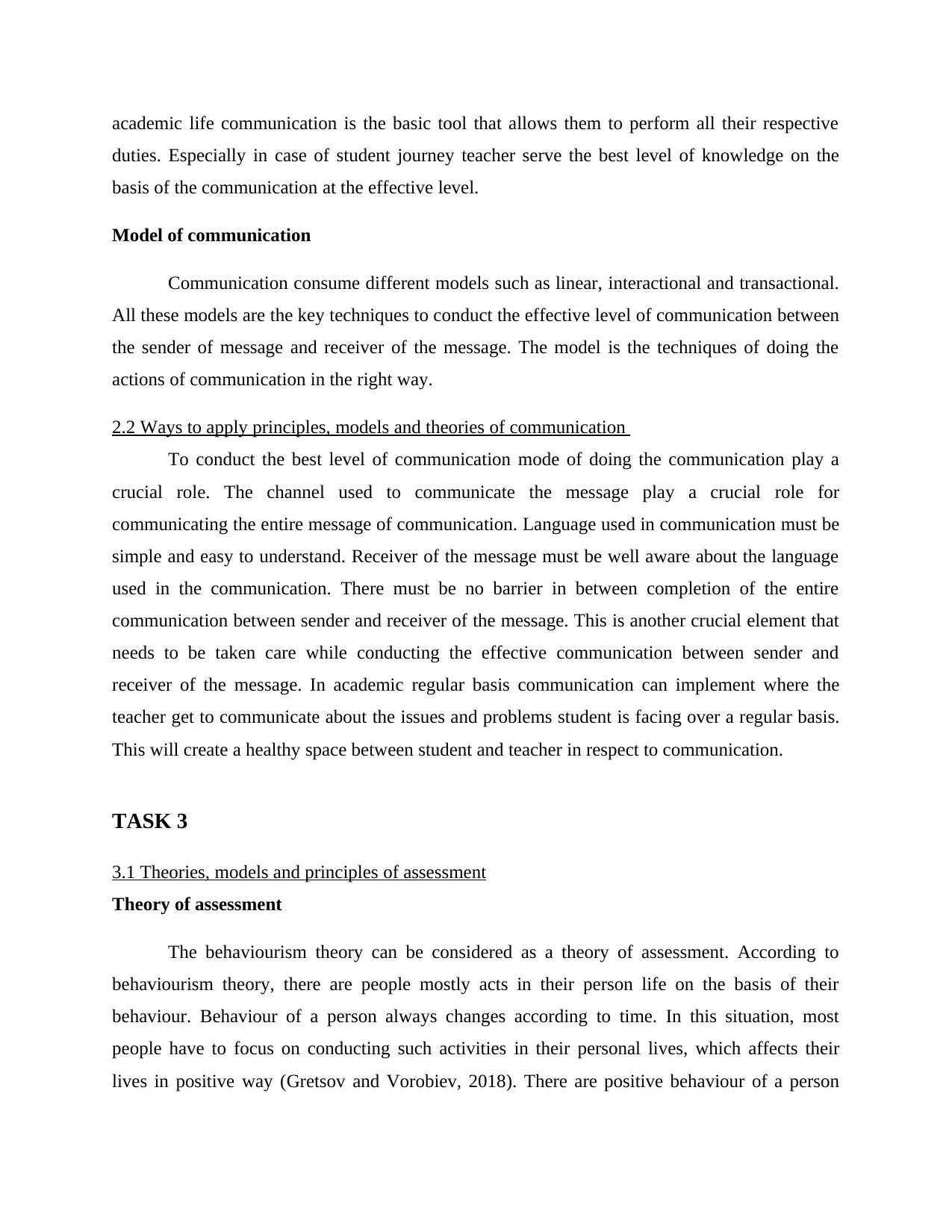
academic life communication is the basic tool that allows them to perform all their respective
duties. Especially in case of student journey teacher serve the best level of knowledge on the
basis of the communication at the effective level.
Model of communication
Communication consume different models such as linear, interactional and transactional.
All these models are the key techniques to conduct the effective level of communication between
the sender of message and receiver of the message. The model is the techniques of doing the
actions of communication in the right way.
2.2 Ways to apply principles, models and theories of communication
To conduct the best level of communication mode of doing the communication play a
crucial role. The channel used to communicate the message play a crucial role for
communicating the entire message of communication. Language used in communication must be
simple and easy to understand. Receiver of the message must be well aware about the language
used in the communication. There must be no barrier in between completion of the entire
communication between sender and receiver of the message. This is another crucial element that
needs to be taken care while conducting the effective communication between sender and
receiver of the message. In academic regular basis communication can implement where the
teacher get to communicate about the issues and problems student is facing over a regular basis.
This will create a healthy space between student and teacher in respect to communication.
TASK 3
3.1 Theories, models and principles of assessment
Theory of assessment
The behaviourism theory can be considered as a theory of assessment. According to
behaviourism theory, there are people mostly acts in their person life on the basis of their
behaviour. Behaviour of a person always changes according to time. In this situation, most
people have to focus on conducting such activities in their personal lives, which affects their
lives in positive way (Gretsov and Vorobiev, 2018). There are positive behaviour of a person
duties. Especially in case of student journey teacher serve the best level of knowledge on the
basis of the communication at the effective level.
Model of communication
Communication consume different models such as linear, interactional and transactional.
All these models are the key techniques to conduct the effective level of communication between
the sender of message and receiver of the message. The model is the techniques of doing the
actions of communication in the right way.
2.2 Ways to apply principles, models and theories of communication
To conduct the best level of communication mode of doing the communication play a
crucial role. The channel used to communicate the message play a crucial role for
communicating the entire message of communication. Language used in communication must be
simple and easy to understand. Receiver of the message must be well aware about the language
used in the communication. There must be no barrier in between completion of the entire
communication between sender and receiver of the message. This is another crucial element that
needs to be taken care while conducting the effective communication between sender and
receiver of the message. In academic regular basis communication can implement where the
teacher get to communicate about the issues and problems student is facing over a regular basis.
This will create a healthy space between student and teacher in respect to communication.
TASK 3
3.1 Theories, models and principles of assessment
Theory of assessment
The behaviourism theory can be considered as a theory of assessment. According to
behaviourism theory, there are people mostly acts in their person life on the basis of their
behaviour. Behaviour of a person always changes according to time. In this situation, most
people have to focus on conducting such activities in their personal lives, which affects their
lives in positive way (Gretsov and Vorobiev, 2018). There are positive behaviour of a person
⊘ This is a preview!⊘
Do you want full access?
Subscribe today to unlock all pages.

Trusted by 1+ million students worldwide

always positively affects its life, and a negative behaviour mostly negatively affects life of a
person. In the learning process, a leaner has to conduct such activities and operations which
always adds some productive value in its personal life. In this dynamic and modern world, there
is huge competition in each sector, in which this is very necessary to a person to adopt this
theory of assessment for gaining very appropriate outcomes. Basically, behaviourism theory of
assessment has currently adopted by many people in market place, because this is one of the best
theories to assess any topic in order to learn new things. There are summative, formative,
diagnostic assessment and Geoff Petty’s feedback are also some major theories of assessment
which has been considered by a person or learner for its overall development of assessment skill.
Basically, these theories can be able to a learner for completing its task of assessment in proper
manner.
Model of assessment
There are two models of assessment generally uses by people or learners in different
academic sessions and market place, named; traditional model and modern model. Traditional
model is the most productive model of assessment, that currently uses by lots of people in market
place. According to traditional model of assessment, each person has to follow specific path of
learning, because without any path proper path of learning, a learner can be distracted, and then
its learning capabilities will be decreased day to day (Rimanoczy, 2016). In this dynamic and
modern world, proper and channelized learning is very important in order gain very positive
outcomes in academic sessions. Traditional model of assessment provides a specific method to
people or learners in marker place for adding some educational values in their daily operations.
Currently most people use this model for the purpose of developing their different skills, abilities
and areas of knowledge. Basically, as a learner skill development or improvement is very
necessary to achieve better results in academic sessions. According to different personality
development trainers, traditional model helps learners to improve their meta-cognitive ability as
well, in which this ability enables to learners in assessing own self to in order to know own
strengths and weaknesses. This is the main reason that, everyone has to adopt the existing
traditional model of assessment for gaining very excellent and better outcomes in daily lives.
Principles of assessment
person. In the learning process, a leaner has to conduct such activities and operations which
always adds some productive value in its personal life. In this dynamic and modern world, there
is huge competition in each sector, in which this is very necessary to a person to adopt this
theory of assessment for gaining very appropriate outcomes. Basically, behaviourism theory of
assessment has currently adopted by many people in market place, because this is one of the best
theories to assess any topic in order to learn new things. There are summative, formative,
diagnostic assessment and Geoff Petty’s feedback are also some major theories of assessment
which has been considered by a person or learner for its overall development of assessment skill.
Basically, these theories can be able to a learner for completing its task of assessment in proper
manner.
Model of assessment
There are two models of assessment generally uses by people or learners in different
academic sessions and market place, named; traditional model and modern model. Traditional
model is the most productive model of assessment, that currently uses by lots of people in market
place. According to traditional model of assessment, each person has to follow specific path of
learning, because without any path proper path of learning, a learner can be distracted, and then
its learning capabilities will be decreased day to day (Rimanoczy, 2016). In this dynamic and
modern world, proper and channelized learning is very important in order gain very positive
outcomes in academic sessions. Traditional model of assessment provides a specific method to
people or learners in marker place for adding some educational values in their daily operations.
Currently most people use this model for the purpose of developing their different skills, abilities
and areas of knowledge. Basically, as a learner skill development or improvement is very
necessary to achieve better results in academic sessions. According to different personality
development trainers, traditional model helps learners to improve their meta-cognitive ability as
well, in which this ability enables to learners in assessing own self to in order to know own
strengths and weaknesses. This is the main reason that, everyone has to adopt the existing
traditional model of assessment for gaining very excellent and better outcomes in daily lives.
Principles of assessment
Paraphrase This Document
Need a fresh take? Get an instant paraphrase of this document with our AI Paraphraser

Reliability, flexibility and fairness are three major principles of assessment which
currently considered by most learners in market place (Welsh, Tullar and Nemati, 2016).
Basically, considerations of these all principles of assessment is very necessary to gain excellent
outcomes by assessing any topic in academic session. The reliability principle of assessment
helps to a learner to be loyal with us various colleagues while studying something in the
academic session. There are teacher or coach is also responsible to aware its learner about never
conduct such attempt in the academic session which will negatively affect to reliability attribute
of an assessment. On the other side, learner have to consider principle of flexibility as well in its
daily learning operations for gaining better outcomes. Generally, principle of flexibility helps to
a learner to be a flexible in the academic session to simply understand any subject. Having
knowledge of different subjects has enabled to a person to be a very excellent and skilled learner.
This is the main reason that, learner should follow principle of flexibility in the terms of be
flexible for gaining each type of knowledge in the academic session.
Lastly, the assessment principle of fairness also plays an effective role to different
learners in market place, in which as a learner, each person has to systematically adhere or
follow the concept of fairness principle to gain better outcomes (Stevenson, 2020). Fairness
principle generally teaches to learners for not conducting any unethical attempt in their daily
operations of learning, because unfair and unethical attempts mostly decreases learning
capabilities of a person. When a learner work in a team or group work, then it needs to avoid
different unfair attempts, like; discriminate other colleagues who comes from lower income
status, caste and ethnicity, not giving credit to actual owner of any study material, etc. That’s
why the assessment principle of fairness plays an effective role to a learner, and every learner is
responsible to follow all principles of assessment for achieving better results or outcomes.
3.2 Ways in which theories, models and principles of assessment can be applied in assessing
learning
Application of theories, models and principle of assessment is not a tough task to a
learner. Basically, for applying these all aspects in assessing learning, a learner has to start
considering the concept of assessment theories in its workplace. There are theories generally
enables to people for assessing any topic in a very proper manner to understand the actual
concept of any topic. On the other side, for applying model of assessment in order to assess
currently considered by most learners in market place (Welsh, Tullar and Nemati, 2016).
Basically, considerations of these all principles of assessment is very necessary to gain excellent
outcomes by assessing any topic in academic session. The reliability principle of assessment
helps to a learner to be loyal with us various colleagues while studying something in the
academic session. There are teacher or coach is also responsible to aware its learner about never
conduct such attempt in the academic session which will negatively affect to reliability attribute
of an assessment. On the other side, learner have to consider principle of flexibility as well in its
daily learning operations for gaining better outcomes. Generally, principle of flexibility helps to
a learner to be a flexible in the academic session to simply understand any subject. Having
knowledge of different subjects has enabled to a person to be a very excellent and skilled learner.
This is the main reason that, learner should follow principle of flexibility in the terms of be
flexible for gaining each type of knowledge in the academic session.
Lastly, the assessment principle of fairness also plays an effective role to different
learners in market place, in which as a learner, each person has to systematically adhere or
follow the concept of fairness principle to gain better outcomes (Stevenson, 2020). Fairness
principle generally teaches to learners for not conducting any unethical attempt in their daily
operations of learning, because unfair and unethical attempts mostly decreases learning
capabilities of a person. When a learner work in a team or group work, then it needs to avoid
different unfair attempts, like; discriminate other colleagues who comes from lower income
status, caste and ethnicity, not giving credit to actual owner of any study material, etc. That’s
why the assessment principle of fairness plays an effective role to a learner, and every learner is
responsible to follow all principles of assessment for achieving better results or outcomes.
3.2 Ways in which theories, models and principles of assessment can be applied in assessing
learning
Application of theories, models and principle of assessment is not a tough task to a
learner. Basically, for applying these all aspects in assessing learning, a learner has to start
considering the concept of assessment theories in its workplace. There are theories generally
enables to people for assessing any topic in a very proper manner to understand the actual
concept of any topic. On the other side, for applying model of assessment in order to assess
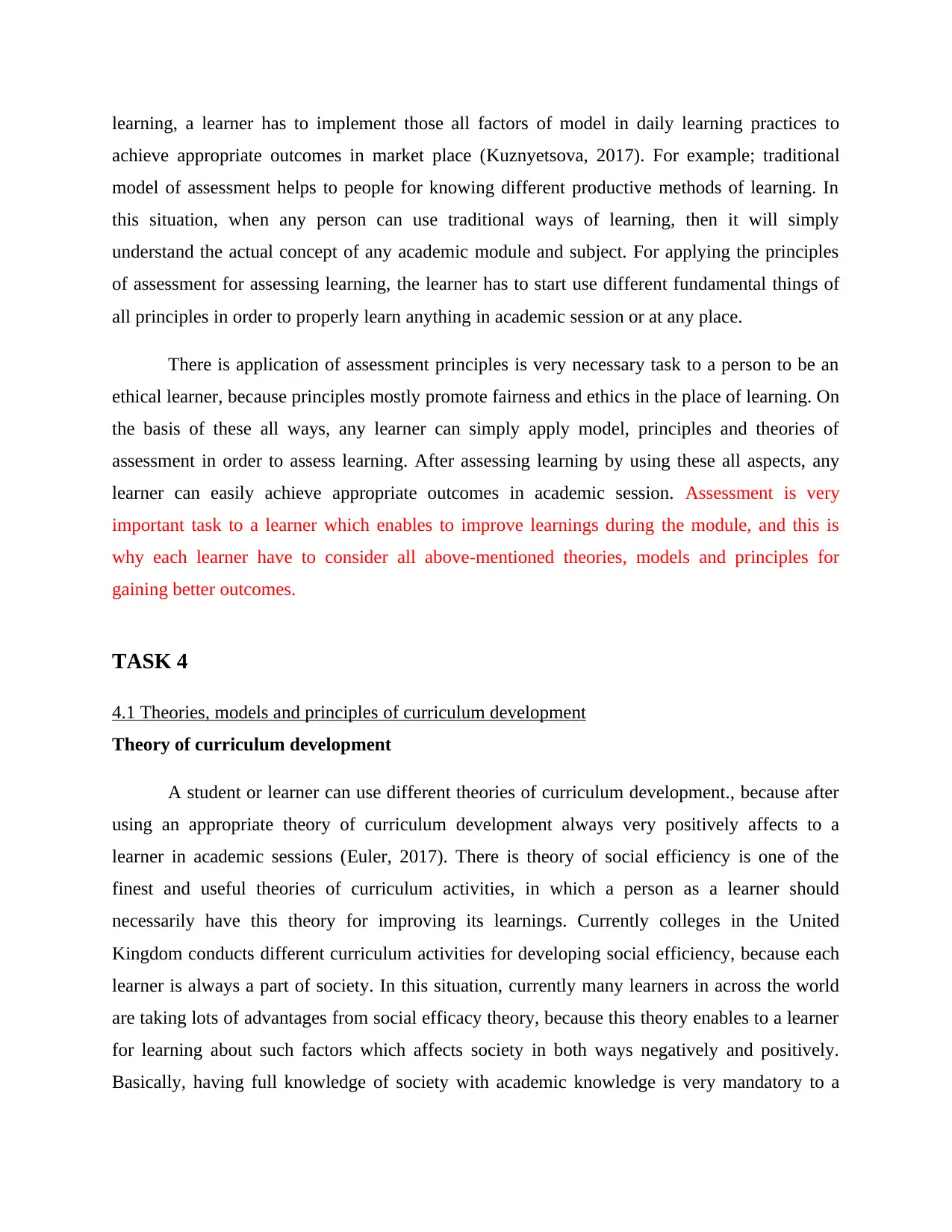
learning, a learner has to implement those all factors of model in daily learning practices to
achieve appropriate outcomes in market place (Kuznyetsova, 2017). For example; traditional
model of assessment helps to people for knowing different productive methods of learning. In
this situation, when any person can use traditional ways of learning, then it will simply
understand the actual concept of any academic module and subject. For applying the principles
of assessment for assessing learning, the learner has to start use different fundamental things of
all principles in order to properly learn anything in academic session or at any place.
There is application of assessment principles is very necessary task to a person to be an
ethical learner, because principles mostly promote fairness and ethics in the place of learning. On
the basis of these all ways, any learner can simply apply model, principles and theories of
assessment in order to assess learning. After assessing learning by using these all aspects, any
learner can easily achieve appropriate outcomes in academic session. Assessment is very
important task to a learner which enables to improve learnings during the module, and this is
why each learner have to consider all above-mentioned theories, models and principles for
gaining better outcomes.
TASK 4
4.1 Theories, models and principles of curriculum development
Theory of curriculum development
A student or learner can use different theories of curriculum development., because after
using an appropriate theory of curriculum development always very positively affects to a
learner in academic sessions (Euler, 2017). There is theory of social efficiency is one of the
finest and useful theories of curriculum activities, in which a person as a learner should
necessarily have this theory for improving its learnings. Currently colleges in the United
Kingdom conducts different curriculum activities for developing social efficiency, because each
learner is always a part of society. In this situation, currently many learners in across the world
are taking lots of advantages from social efficacy theory, because this theory enables to a learner
for learning about such factors which affects society in both ways negatively and positively.
Basically, having full knowledge of society with academic knowledge is very mandatory to a
achieve appropriate outcomes in market place (Kuznyetsova, 2017). For example; traditional
model of assessment helps to people for knowing different productive methods of learning. In
this situation, when any person can use traditional ways of learning, then it will simply
understand the actual concept of any academic module and subject. For applying the principles
of assessment for assessing learning, the learner has to start use different fundamental things of
all principles in order to properly learn anything in academic session or at any place.
There is application of assessment principles is very necessary task to a person to be an
ethical learner, because principles mostly promote fairness and ethics in the place of learning. On
the basis of these all ways, any learner can simply apply model, principles and theories of
assessment in order to assess learning. After assessing learning by using these all aspects, any
learner can easily achieve appropriate outcomes in academic session. Assessment is very
important task to a learner which enables to improve learnings during the module, and this is
why each learner have to consider all above-mentioned theories, models and principles for
gaining better outcomes.
TASK 4
4.1 Theories, models and principles of curriculum development
Theory of curriculum development
A student or learner can use different theories of curriculum development., because after
using an appropriate theory of curriculum development always very positively affects to a
learner in academic sessions (Euler, 2017). There is theory of social efficiency is one of the
finest and useful theories of curriculum activities, in which a person as a learner should
necessarily have this theory for improving its learnings. Currently colleges in the United
Kingdom conducts different curriculum activities for developing social efficiency, because each
learner is always a part of society. In this situation, currently many learners in across the world
are taking lots of advantages from social efficacy theory, because this theory enables to a learner
for learning about such factors which affects society in both ways negatively and positively.
Basically, having full knowledge of society with academic knowledge is very mandatory to a
⊘ This is a preview!⊘
Do you want full access?
Subscribe today to unlock all pages.

Trusted by 1+ million students worldwide
1 out of 22
Related Documents
Your All-in-One AI-Powered Toolkit for Academic Success.
+13062052269
info@desklib.com
Available 24*7 on WhatsApp / Email
![[object Object]](/_next/static/media/star-bottom.7253800d.svg)
Unlock your academic potential
Copyright © 2020–2025 A2Z Services. All Rights Reserved. Developed and managed by ZUCOL.




